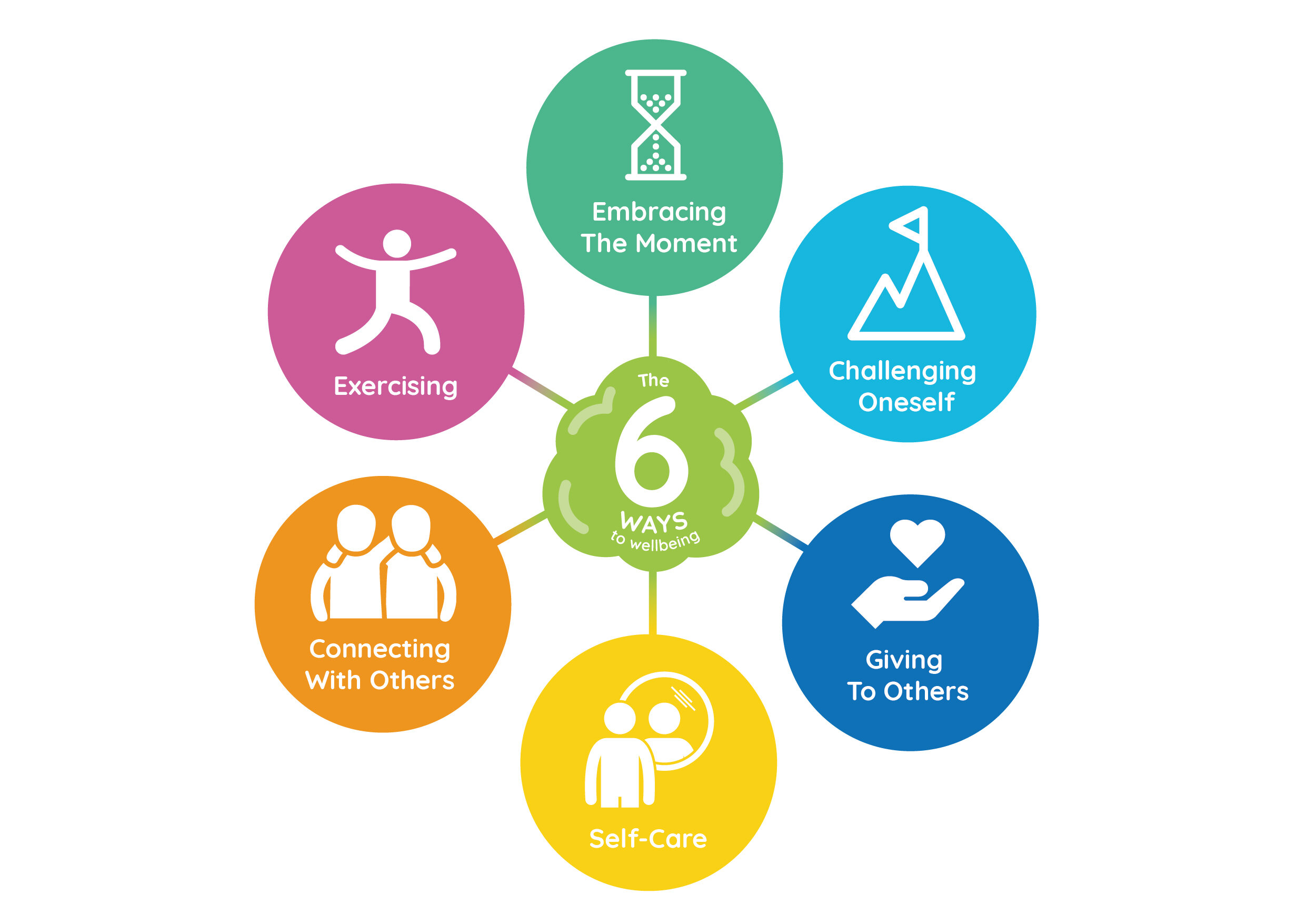Digging into The 6 Ways to Wellbeing with Dr Geetanjali Basarkod
The termly themes of the Connect Curriculum are informed by the Six Ways to Well-Being—six everyday actions that can help individuals improve their well-being indirectly. Before we get to the behaviours themselves, I want to describe why this “indirectly” aspect is important. Plenty of research shows direct attempts to increase positive mental states like happiness and reduce negative states like sadness might backfire and actually make us feel worse. For instance, trying to avoid negative thoughts by suppressing them or distracting yourself can increase the frequency of those negative thoughts, rather than reduce them. Even if such techniques make you feel better in the short-term, they may be counterproductive in the long run.
One solution to this issue comes from Contextual Behavioural Science (CBS). A key characteristic of CBS is its attempt to move away from changing the content of our thoughts, (i.e., trying to think happy thoughts), and instead increasing the amount of valued action a person engages in. Valued action is anything that an individual finds important and meaningful; it’s less about changing how we feel and more about our willingness to do the things that matter.
This is where the Six Ways to Well-Being comes in. Recent research shows that there are six everyday behaviours that people can engage in to indirectly promote well-being. These are:
Connecting with Others:
Description: This is how you engage in social relationships with the people around you (e.g., family, friends, neighbours, or community groups).
Benefits: Having good quality social relationships provide us with love, intimacy, reassurance of worth, and support. For people with mental ill-health diagnosis, increasing social interactions is associated with reduced remissions as well as better social functioning, and successful placement in the community.
Examples: Speaking to a friend over the phone or discussing your day with family over dinner.
Challenging Oneself:
Description: This is how you challenge yourself and learn new things.
Benefits: Learning new things enhances self-esteem, improves social interactions, provides a more active life, and increases optimism, self-efficacy, and self-confidence.
Examples: Learning to play the piano, fixing something, developing your coding skills, taking on new responsibilities, or reading up about something you learnt at school.
Giving to Others:
Description: This is how you give to others or help others.
Benefits: Helping behaviours have been linked to higher levels of happiness, increased well-being, life satisfaction, mental health, and self-esteem. Also associated with lower levels of hopelessness and depressive symptoms.
Examples: Volunteering your time at the local shelter, doing something kind for a friend, or donating to charity (check out a list of evidence-based charities here, that help maximise the good you can do with each dollar spent).
Engaging in Physical Activity:
Description: This is how you engage in physical activity and exercise.
Benefits: Engaging in physical activity can reduce existing symptoms of depression and anxiety and prevent new symptoms. It is also associated with improved physical function, lower blood pressure, and reduced illness, higher levels of happiness and life-satisfaction.
Examples: Going for a walk or run, dancing, cycling, yoga, doing body weight exercises at home.
Embracing the Moment:
Description: This is how you get fully involved in the present – using your complete attention and awareness to do what you are doing in that moment.
Benefits: Being mindful can help to reduce distress, depression and anxiety and increase positive affect, life satisfaction, optimism and self-esteem.
Examples: Being curious, noticing something unusual, paying full attention to a conversation you’re having or to the taste of your food.
Caring for Oneself:
Description: This is how you look after your mind and body.
Benefits: Eating well has been associated with a positive effect on mood and behaviour, better cognitive functioning and also reduced illness. Sleep has been associated with mood-regulation, pain modulation, optimism, alertness, quality of life, and well-being.
Examples: Maintaining a healthy diet, sleeping eight hours each night, having a regular bedtime, taking your vitamins and medicines on time, and doing something relaxing after a hard day.
An important note to make here is that our motivations for engaging in the above behaviours is crucial. Research shows that we see the benefits of increased well-being when we perform these behaviours autonomously (i.e., because we want to do them), not when we do so because we feel we have to. It is also more likely that we will continue to engage in these behaviours if they are done autonomously.
Thankfully, there are things we can do to increase our sense of autonomy. One great way of doing so is by creating choice. For instance, you can engage in physical activity through any means you enjoy – if you don’t like running, try putting on a dance video and following along instead. Alternatively, you could invite a friend for a walk, which would also help you connect with others!
The above six behaviours – combined with the motivations for engaging in them – can help us improve our mental health and well-being. In addition, doing so can enrich our lives by increasing our behavioural repertoire and focusing our mental efforts on what we find meaningful. It is for these reasons that the Six Ways to Well-Being informs the termly themes of Connect.
Dr. Geetanjali Basarkod is a postdoctoral researcher at the Institute for Positive Psychology and Education, Australian Catholic University. She was awarded her PhD in 2019, for which she developed the Six Ways to Well-Being Questionnaire (6W-WeB), supervised by Professor Joseph Ciarrochi and Dr. Baljinder Sahdra. Details about this measure can be found here (thesis) and here (preprint journal article). Geet has published papers on a variety of topics, including mindfulness, psychological flexibility, body image, and academic achievement and self-beliefs. The Six Ways to Well-Being was based substantially on past work done by the New Economic Foundation, that comprised the first five behaviours mentioned above.


